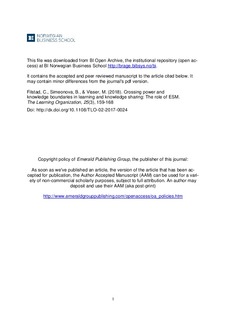Crossing power and knowledge boundaries in knowledge sharing: the role of EMS
Journal article, Peer reviewed
Accepted version
Permanent lenke
http://hdl.handle.net/11250/2500029Utgivelsesdato
2018Metadata
Vis full innførselSamlinger
- Publikasjoner fra CRIStin - BI [1015]
- Scientific articles [2181]
Originalversjon
The Learning Organization, 2018, 25(3), 159-168 http://dx.doi.org/10.1108/TLO-02-2017-0024Sammendrag
Purpose: The purpose of this study is to investigate the crossing of knowledge and power boundaries within a bureaucratic organization by using enterprise social media (ESM). (Carlile’s 2002) boundary crossing framework is used to guide this research.
Design/methodology/approach: This is a qualitative study based on semi-structured interviews and observations in a large Norwegian public sector organization.
Findings: The authors find that investigating crossing knowledge and power boundaries by using ESM is problematic at syntactic, semantic and pragmatic levels. ESM is used predominantly for sharing, storing and retrieving explicit knowledge, which is a display of crossing the information-processing boundary. Hence, the possibilities of shifts in formal power positions where all employees can participate on equal terms is not achieved. On the contrary, as shared meaning on how to use EMS, taking the perspective of other on how to share knowledge and thus creating new knowledge practices in EMS by overcoming these knowledge barriers is not evident. Therefore, examples of crossing the semantic and pragmatic knowledge boundaries are rarely found.
Research limitations/implications: The framework could be applied to a variety of contexts to further explore the role of ESM in learning and knowledge sharing and its ability to cross power and knowledge boundaries.
Originality/value: This paper addresses a gap in the literature around discussions of power, trust, boundary crossing and the use of ESM for knowledge sharing and learning.
